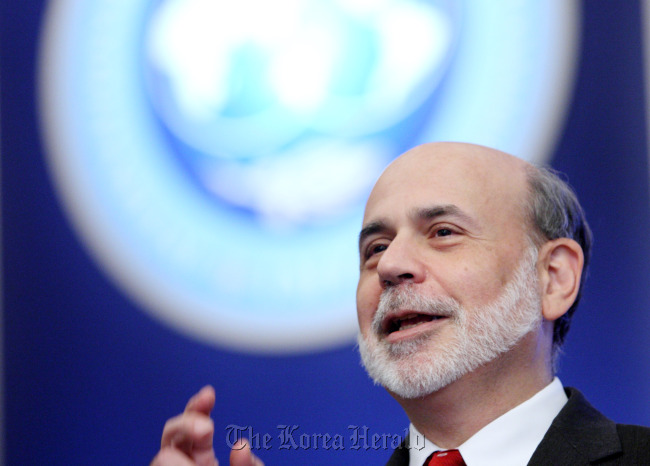 |
Ben Bernanke |
WASHINGTON (AFP) ― Despite signs of revival in the housing sector and a lower jobless rate, a cautious U.S. Federal Reserve is expected to keep its stimulus programs in place at its policy meeting this week.
Six weeks after breaking out a new bond-buying program labeled QE3 to shore up the economy, analysts see little reason to expect the Fed’s policy board, the Federal Open Market Committee, to reverse direction in its session on Tuesday and Wednesday.
The signs of recovery remain too feeble, and the overhanging risks too many ― the U.S. election on Nov. 6 and the “fiscal cliff” crunch, the eurozone crisis and China’s slowdown ― to justify a policy change.
“The recent upturn in economic activity is not enough to force the Fed’s hand to change now. It is far too soon for the Fed to react and will more likely reaffirm their commitment to QE3,” said Chris Low at FTN Financial.
“After all, the economy is still adding fewer than 150,000 jobs a month, not enough to cover demographic changes or meet (Fed chairman Ben) Bernanke’s goals,” Low said.
At their last meeting, the Fed launched QE3 ― a “quantitative easing” operation of buying in $40 billion worth of bonds monthly to press long-term interest rates lower ― with the express aim of sparking companies to invest and hire.
Bernanke’s concern over the slow pace of job creation has mounted over the past year and by the Sept. 12-13 FOMC meeting, most of the members of the policy board had gotten in line behind him.
Likewise, his view that inflation is not a threat that requires more caution about stimulus has also been endorsed by the committee members.
That has not likely changed in the weeks since then, despite a surprise 0.3 percentage point fall in the national unemployment rate in September, to 7.8 percent ― the lowest level since January 2009.
While the baseline number looked good, other figures ― the overall number of unemployed, and those who dropped out of the workforce ― indicated that the U.S. economy’s jobs machine remains week.
Since then other data has been mixed: consumer spending seems stronger and consumer sentiment is higher, but industrial production has weakened and exports are down.
The Fed’s Beige Book survey of regional economies released Oct. 10 recognized only a modest pickup in activity since August.
But that could be enough to change the tenor of the Fed’s discussions, from one of mulling how to deal with a deteriorating economy to one of how to anticipate a potential breakout.
The Fed still has to assess the two targets of its interest rate policy: its mandates of managing inflation and keeping unemployment down.
Compared to last year, says Narayana Kocherlakota, head of the Fed’s Minneapolis branch, the worry about inflation among FOMC members has mostly disappeared, despite its key interest rate still being held at next to zero.
“The terms ‘hawkish’ and ‘dovish’ presume that the committee faces a tension between its two mandates,” he said in an Oct. 10 speech.
“But the committee does not see any tension between its two mandates now.
And its long-run unemployment forecasts suggest that it does not anticipate any tension between the two mandates until the unemployment rate is considerably lower.”
Indeed, in the September meeting, Bernanke made clear that the low rate policy will remain in place until there is a substantial improvement in the country’s employment situation.
The FOMC is expected then to talk more about how it will signal its views and intentions ― whether, for instance, to set a specific goal for the unemployment rate, at which it might increase interest rates.
Nomura analysts said they expect FOMC participants “to spend considerable time in furthering the discussion around how to communicate the Fed’s intention and craft a consensus forecast,” as well as what they will do when a previous stimulus program dubbed Operation Twist ends.








